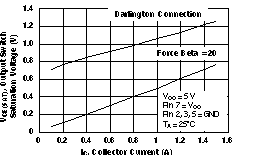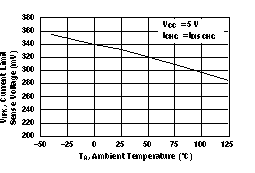SLLS654C April 2005 – December 2014 MC33063A-Q1
PRODUCTION DATA.
- 1 Features
- 2 Applications
- 3 Description
- 4 Revision History
- 5 Pin Configuration and Functions
- 6 Specifications
- 7 Detailed Description
- 8 Application and Implementation
- 9 Power Supply Recommendations
- 10Layout
- 11Device and Documentation Support
- 12Mechanical, Packaging, and Orderable Information
Package Options
Mechanical Data (Package|Pins)
- D|8
Thermal pad, mechanical data (Package|Pins)
Orderable Information
6 Specifications
6.1 Absolute Maximum Ratings(1)
over operating free-air temperature range (unless otherwise noted)| MIN | MAX | UNIT | ||
|---|---|---|---|---|
| Supply voltage, VCC | 40 | V | ||
| Comparator Inverting Input voltage range, VIR | –0.3 | 40 | V | |
| Switch Collector voltage, VC(switch) | 40 | V | ||
| Switch Emitter voltage, VE(switch) | VPIN1 = 40 V | 40 | V | |
| Switch Collector to Switch Emitter voltage, VCE(switch) | 40 | V | ||
| Driver Collector voltage, VC(driver) | 40 | V | ||
| Driver Collector current, IC(driver) | 100 | mA | ||
| Switch current, ISW | 1.5 | A | ||
| Operating virtual junction temperature, TJ | 150 | °C | ||
| Storage temperature, Tstg | –65 | 150 | °C | |
(1) Stresses beyond those listed under absolute maximum ratings may cause permanent damage to the device. These are stress ratings only, and functional operation of the device at these or any other conditions beyond those indicated under "recommended operating conditions" is not implied. Exposure to absolute-maximum-rated conditions for extended periods may affect device reliability.
6.2 ESD Ratings
| VALUE | UNIT | |||||
|---|---|---|---|---|---|---|
| V(ESD) | Electrostatic discharge | Human body model (HBM), per AEC Q100-002(1) | ±2000 | V | ||
| Charged device model (CDM), per AEC Q100-011 | Corner pins (1, 4, 5, and 8) | ±750 | ||||
| Other pins | ±500 | |||||
(1) AEC Q100-002 indicates HBM stressing is done in accordance with the ANSI/ESDA/JEDEC JS-001 specification.
6.3 Recommended Operating Conditions
| MIN | NOM | MAX | UNIT | |||
|---|---|---|---|---|---|---|
| VCC | Supply voltage | 3 | 40 | V | ||
| TA | Operating free-air temperature | –40 | 125 | °C | ||
6.4 Thermal Information
| THERMAL METRIC(1) | MC33063A-Q1 | UNIT | |
|---|---|---|---|
| D | |||
| 8 PINS | |||
| RθJA | Junction-to-ambient thermal resistance(2)(3) | 121.9 | °C/W |
| RθJC(top) | Junction-to-case (top) thermal resistance | 68.1 | |
| RθJB | Junction-to-board thermal resistance | 62.3 | |
| ψJT | Junction-to-top characterization parameter | 19.9 | |
| ψJB | Junction-to-board characterization parameter | 61.8 | |
| RθJC(bot) | Junction-to-case (bottom) thermal resistance | N/A | |
(1) For more information about traditional and new thermal metrics, see the IC Package Thermal Metrics application report, SPRA953.
(2) Maximum power dissipation is a function of TJ(max), RθJA, and TA. The maximum allowable power dissipation at any allowable ambient temperature is PD = (TJ(max) – TA) / RθJA. Operating at the absolute maximum TJ of 150°C can affect reliability.
(3) The package thermal impedance is calculated in accordance with JESD 51-7.
6.5 Oscillator Characteristics
VCC = 5 V, TA = full operating range (unless otherwise noted) (see block diagram)| PARAMETER | TEST CONDITIONS | TA | MIN | TYP | MAX | UNIT | |
|---|---|---|---|---|---|---|---|
| fosc | Oscillator frequency | VPIN5 = 0 V, CT = 1 nF | 25°C | 24 | 33 | 42 | kHz |
| Ichg | Charge current | VCC = 5 V to 40 V | 25°C | 24 | 35 | 42 | μA |
| Idischg | Discharge current | VCC = 5 V to 40 V | 25°C | 140 | 220 | 260 | μA |
| Idischg/Ichg | Discharge-to-charge current ratio | VPIN7 = VCC | 25°C | 5.2 | 6.5 | 7.5 | |
| VIpk | Current-limit sense voltage | Idischg = Ichg | 25°C | 250 | 300 | 350 | mV |
6.6 Output Switch Characteristics(1)
VCC = 5 V, TA = full operating range (unless otherwise noted). See the Functional Block Diagram.| PARAMETER | TEST CONDITIONS | TA | MIN | TYP | MAX | UNIT | |
|---|---|---|---|---|---|---|---|
| VCE(sat) | Saturation voltage – Darlington connection |
ISW = 1 A, pins 1 and 8 connected | Full range | 1 | 1.3 | V | |
| VCE(sat) | Saturation voltage – non-Darlington connection(2) |
ISW = 1 A, RPIN8 = 82 Ω to VCC, Forced β ~ 20 |
Full range | 0.45 | 0.7 | V | |
| hFE | DC current gain | ISW = 1 A, VCE = 5 V | 25°C | 50 | 75 | ||
| IC(off) | Collector off-state current | VCE = 40 V | Full range | 0.01 | 100 | μA | |
(1) Low duty-cycle pulse testing is used to maintain junction temperature as close to ambient temperature as possible.
(2) In the non-Darlington configuration, if the output switch is driven into hard saturation at low switch currents (≤300 mA) and high driver currents (≥30 mA), it may take up to 2 μs for the switch to come out of saturation. This condition effectively shortens the off time at frequencies ≥30 kHz, becoming magnified as temperature increases. The following output drive condition is recommended in the non-Darlington configuration:
Forced β of output switch = IC,SW / (IC,driver – 7 mA) ≥ 10, where ∼7 mA is required by the 100-Ω resistor in the emitter of the driver to forward bias the Vbe of the switch.
Forced β of output switch = IC,SW / (IC,driver – 7 mA) ≥ 10, where ∼7 mA is required by the 100-Ω resistor in the emitter of the driver to forward bias the Vbe of the switch.
6.7 Comparator Characteristics
VCC = 5 V, TA = full operating range (unless otherwise noted). See the Functional Block Diagram.| PARAMETER | TEST CONDITIONS | TA | MIN | TYP | MAX | UNIT | |
|---|---|---|---|---|---|---|---|
| Vth | Threshold voltage | 25°C | 1.225 | 1.25 | 1.275 | V | |
| Full range | 1.21 | 1.29 | |||||
| ΔVth | Threshold-voltage line regulation | VCC = 5 V to 40 V | Full range | 1.4 | 5 | mV | |
| IIB | Input bias current | VIN = 0 V | Full range | –20 | –400 | nA | |
6.8 Total Device Characteristics
VCC = 5 V, TA = full operating range (unless otherwise noted). See the Functional Block Diagram.| PARAMETER | TEST CONDITIONS | TA | MIN | MAX | UNIT | |
|---|---|---|---|---|---|---|
| ICC | Supply current | VCC = 5 V to 40 V, CT = 1 nF, VPIN7 = VCC, VPIN5 > Vth, VPIN2 = GND, All other pins open |
Full range | 4 | mA | |
6.9 Typical Characteristics

Oscillator Timing Capacitor

Collector Current (Common-Emitter Configuration)


Emitter Current (Emitter-Follower Configuration)
